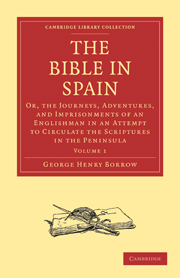 The Bible in Spain
The Bible in Spain Summary
Little can be said with respect to the town of Cordova, which is a mean dark gloomy place, full of narrow streets and alleys, without squares or public buildings worthy of attention, save and except its far-famed cathedral; its situation, however, is beautiful and picturesque. Before it runs the Guadalquivir, which, though in this part shallow and full of sandbanks, is still a delightful stream; whilst behind it rise the steep sides of the Sierra Morena, planted up to the top with olive groves. The town or city is surrounded on all sides by lofty Moorish walls, which may measure about three quarters of a league in circumference; unlike Seville, and most other towns in Spain, it has no suburbs.
I have said that Cordova has no remarkable edifices, save its cathedral; yet this is perhaps the most extraordinary place of worship in the world. It was originally, as is well known, a mosque, built in the brightest days of Arabian dominion in Spain: in shape it was quadrangular, with a low roof, supported by an infinity of small and delicately rounded marble pillars, many of which still remain, and present at first sight the appearance of a marble grove; the greater part, however, were removed when the Christians, after the expulsion of the Moslems, essayed to convert the mosque into a cathedral, which they effected in part by the erection of a dome, and by clearing an open space for a choir.
- Type
- Chapter
- Information
- The Bible in SpainOr, the Journeys, Adventures, and Imprisonments of an Englishman in an Attempt to Circulate the Scriptures in the Peninsula, pp. 345 - 364Publisher: Cambridge University PressPrint publication year: 2010First published in: 1843


